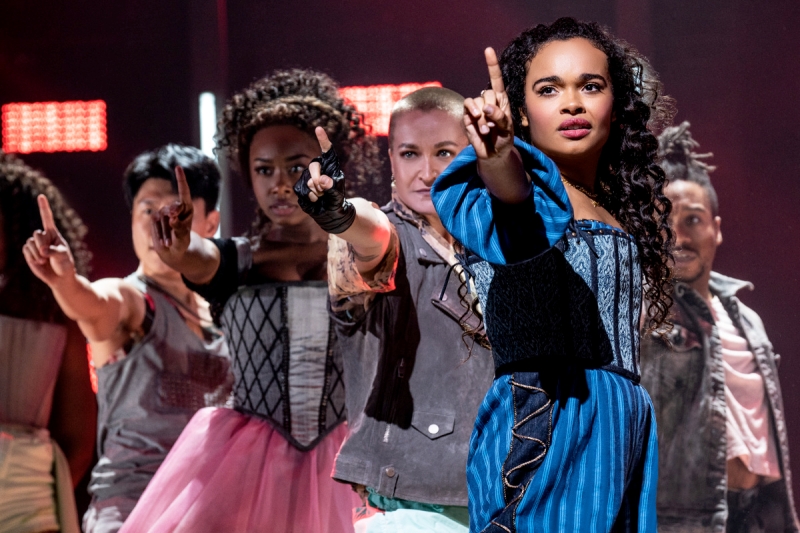Part B:
& JULIET
Book by David West Read
Music and Lyrics by Max Martin
Directed by Dominic Fallacaro
Stephen Sondheim Theatre
Official Website
Reviewed by David Spencer
More of the same to be found in & Juliet, in which, Shakespeare’s wife, Anne Hathaway (Betsy Wolfe), expressing dissatisfaction with the end of Romeo & Juliet, noodges hubby Will (Stark Sands) to resurrect young Juliet (Lorna Courtney) to explore the fate of an empowered female’s choosing. Will relents, and throughout the proceedings they wrest control of the authorship from one another—in part by inserting new characters that they themselves play—throwing new challenges into the mix; until Will goes one plot point too far, violating their agreement to keep moving beyond the events of the previous play. Will does this to to create, or so he claims, “conflict”— which stresses their relationship even as the relationships within the show are tested. Theirs is not the only role play along the way.
Because the very raison d’être of David West Read’s libretto is to mix and match familiar Shakespeare tropes in a contemporary context, the characters can’t evolve much beyond archetypes and predictable reversals; compounding this is the fact that the songs are not original to the show: They’re from the catalog of pop music hitmaker Max Martin, so not only must the action be engineered toward songs that have only general application—denying characters the opportunity to express themselves with genuine specificity…but the songs them selves can only be anthemic statements of the current emotional state and/or epiphanic resolve. If you’re not into the theme-park atmosphere executed with a kind of merciless elan by director Dominic Fallacaro (which extends to all aspects of design) and the chart-topper/music video choreography—and there are those who are and those who will be—it can all become a little exhausting.
And, of course, it’s another empowerment fable.
There’s nothing-nothing-nothing wrong in telling a tale about empowerment. Indeed, when issues start coming to light, there are always the ice-breaker dramas; they’re a little case-history-like, a little moralistic, because they’re the bracing FIRST that puts forth an issue in its most textbook configuration, with characters who are archetypes because they represent truisms that need to be mainstreamed: An Unmarried Woman, Days of Wine and Roses, That Certain Summer, etc. But after that, the storytelling needs to be specific to a milieu, to unique characters. Offhand, I can think of two movies: Norma Rae, in which a woman spearheads unionization in the face of powerful forces against; and Brubaker, about a crusading warden who takes over a prison camp and, appalled at the neglect and abuse of the prison system and the horrific treatment of the inmates, embarks upon a crusade to renovate everything, top to bottom—in the face of powerful forces against.
Of course, all of those are theatrical and TV movies.
Theatre development moves more slowly. And the theatre is less friendly to “dramatized case history” than film. So theatre once traditionally approached issues via what I call “the gathering play”: Each character is representative of a facet—one from column A, one from column B, etc. to show you the cross-section of a society within a society: such as the family and others in A Raisin in the Sun; or the birthday party guests in The Boys in the Band—but because the circumstance that brings or binds them together is unique, they can express themselves and be played uniquely. These plays tend to be about the need for empowerment.
But the more variegated the mainstream has become, keeping pace with the technology of communication, storytelling venues and social media, the subtler and more idiosyncratic empowerment plays have become.
One might even argue that A Strange Loop is about finding empowerment via self-expression. But it doesn’t follow a neat trajectory. And it’s surreal. And in a good way, a little bit crazy. It not only has no neat moral, it insists upon not giving you one. But it sure gives you stuff to debate.
A fable about empowerment, though, not so much. Because there’s nothing to think about. You’re sold before it starts.
And masters have failed at it. Comden & Green, Larry Grossman and Hal Prince put forth their empowerment fable in A Doll’s Life—their sequel to a classic work, Ibsen’s A Doll’s House—what happens to Nora after she leaves Torvald’s house? Well, she…um…learns to be empowered. The show had an elegant score, sophistication, wit and absolutely nothing new to say. At a minimum it showed up ten years too late, and bounced on the first weekend that showed up. And that was 1985.
Admittedly, the Zeitgeist is different now. Diversity and inclusion are, for the moment, ingredients that most populist entertainments must have in the mix, one way or another. & Juliet will have a happier run than A Doll’s Life because it presses the buttons and ticks the boxes of reassurance and righteousness for a much younger audience who want to be at the forefront of a revolution—some of whom are. With cause.
But that doesn’t alter the fact that, underneath, & Juliet is the same old hat on the same old horse. With familiar song standards. The barn isn’t even that new—it just looks new. For a theme park. Accent on theme.
Link to Part A: Only Gold
Link to Part C: Almost Famous
